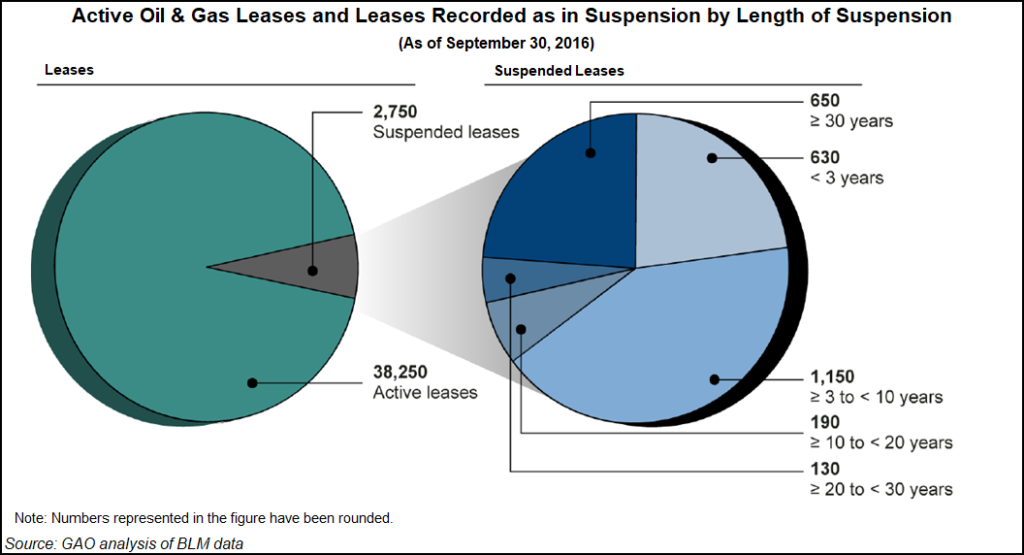E&P | NGI All News Access | Regulatory
GAO Says BLM Could Improve Oversight of Suspended Oil, Gas Leases
The Interior Department’s Bureau of Land Management (BLM) needs additional information to determine why a small number of oil and natural gas leases are currently under suspension and therefore not earning revenue for the federal government, the U.S. Government Accountability Office (GAO) said in a report issued Tuesday.

In a 42-page report to members of Congress, GAO found that it was difficult to determine the reasons behind the suspensions, in part, because the BLM currently does not require that information in its database for mineral and land use, aka Legacy Rehost 2000 (LR2000).
“To obtain this information, BLM officials would have to review the official lease files, of which many are in hard copy,” GAO said, adding that BLM officials interviewed for the report said “additional, more detailed information in the database on reasons for suspensions would be helpful in tracking lease suspensions.”
According to GAO, at the end of fiscal year 2016, LR2000 contained information on about 41,000 oil and gas leases, covering 28.2 million subsurface acres in 32 states. Of those leases, 2,749 had been recorded as suspended, covering 3.38 million acres in total. Utah had the highest number of suspended leases at 731, followed by Wyoming (687), Montana (607), Colorado (180) and New Mexico (158).
Broken down by length of the suspension, 629 leases had been suspended for less than three years, while 1,154 leases had been suspended for at least three years, but less than a decade. Another 195 leases had been suspended for at least 10 years, but less than 20, and 126 leases had been set aside for at least 20 years, but less than 30. GAO found that 645 oil and gas leases have been on ice for 30 years or longer.
Utah’s suspended leasehold acreage totaled 1.05 million acres, while Montana’s totaled 992,145 acres. In Wyoming, 568,775 acres had been tied up, followed by Colorado (236,901 acres) and Oregon (172,759), which came in seventh in terms of number of leases suspended, with 105. New Mexico placed seventh in terms of acreage, with 84,256 acres under suspension.
In a sample of 48 leases in Montana and Wyoming that were under suspension, GAO found that 16 had been suspended “for large-scale environmental concerns, such as wilderness or wildlife protection areas or environmental reviews that affected large parcels of land.” Another 14 leases had been suspended “because BLM required additional time to complete its review of the operator’s drilling permit application.” Leases in the former category had been suspended six to 38 years, while those in the latter ranged from one to 13 years.
BLM is responsible for managing approximately 700 million acres of subsurface mineral estate across the United States.
A list of four recommendations was issued by GAO, the first of which calls for the BLM director to include a field noting the reasons for suspensions as the bureau updates or replaces its database. It also recommended that the director develop official procedures for the BLM to follow as it monitors oil and gas lease suspensions, including when to conduct monitoring activities.
GAO also recommended that the director “require cognizant officials in headquarters and states offices to conduct top-level reviews of field offices’ monitoring of oil and gas lease suspension, as well as official lease files and databases to ensure they are current and complete.” And as BLM updates or replaces the LR2000 system, the director “should ensure the development mechanisms, such as standardized summary reports on lease suspensions,” are available to BLM staffers.
Joseph Balash, BLM’s assistant secretary for land and minerals management, told GAO in a May 22 letter that BLM concurs with all of its recommendations, adding that the bureau “generally agrees with the overall findings of the draft report.”
Earlier this month, GAO issued a separate report that found costs and liabilities associated with orphaned oil and gas wells are likely increasing, but BLM had been doing an inadequate job of keeping track of the trends.
© 2024 Natural Gas Intelligence. All rights reserved.
ISSN © 2577-9877 | ISSN © 2158-8023 |
